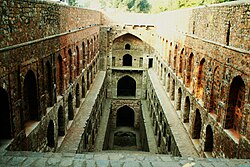Agrawal (anglicised as Agarwal, Agerwal, Agrawala, Agarwala, Agarwalla, Aggarwal, Agarawal, Agarawala) is a Bania community found throughout northern, central and western India, mainly in the states of Rajasthan, Haryana, Punjab, Chandigarh, Himachal Pradesh, Uttarakhand, Delhi, Chhattisgarh, Gujarat and Uttar Pradesh. Members of the Agarwal community were also found in what are now the Pakistani provinces of Punjab and Sindh, though at the time of the partition of India, most of them migrated across the newly created border to independent India. Agarwals follow Jainism and Vaishnava Hinduism. Some also converted to Hinduism during the Bhakti movement. Agrawals are divided into eighteen exogamous clans (gotras). Many members of this community use their caste name Agarwal as their surname, while others use that of their gotras.
Members of the Agrawal community are known for their business skills and have for many years been influential and prosperous in India. Even in modern-day tech and ecommerce companies, they continue to dominate. It was reported in 2013, that for every 100 in funding for e-commerce companies in India, 40 went to firms founded by an Agrawal.
Legend

Agrasen ki Baoli in Delhi, which was built by the Agarwal during the Tughlaq dynasty in India.
The Agrawals claim descent from king Agrasen of the Solar Dynasty.
History
Agrawals are a part of the larger Bania community, which includes other mercantile communities, such as the Maheshwari and Oswals.
Migration to Rajput kingdoms
During the era of Islamic administrative rule in India, some Agarwal, as with the Saraogi, migrated to the Bikaner State. The Malkana include Muslim Agarwals, who converted from Hinduism to Islam during this time and were given land tracts along the Yamuna by Afghan rulers.
In the early 15th century, Agrawals (sweet maker) flourished as a Halwai trader community, under the Tomaras of Gwalior. According to several Sanskrit inscription at the Gwalior Fort in Gwalior District, several traders (Sanghavi Kamala Simha, Khela Brahmachari, Sandhadhip Namadas etc.) belonging to Agrotavansha (Agrawal clan) supported the sculptures and carving of idols at the place. Historian K.C. Jain comments:
Golden Age of the Jain Digambar Temple in Gwalior under the Tomara rulers inspired by the Kashtha Bhattarakas and their Jaina Agrawal disciples who dominated the Court of father and son viz. Dungar Singh (1425-59)and Kirti Singh (1459-80) with the Poet-Laureate Raighu as their mouthpiece and spokesman, a centenarian author of as many as thirty books, big and small of which two dozen are reported to be extant today. Verify the advent of the Hisar-Firuza-based Jain Agrawals who functioned as the ministers and treasurers of the ruling family had turned the Rajput State of Gwalior into a Digambara Jain Centre par excellence representing the culture of the Agrawal multi-millionner shravakas as sponsored by them.
Migration to Eastern India
Later, during the Mughal rule, and during the British East India Company administration, some Agrawals migrated to Bihar and Calcutta, who became the major component of the Marwaris.
